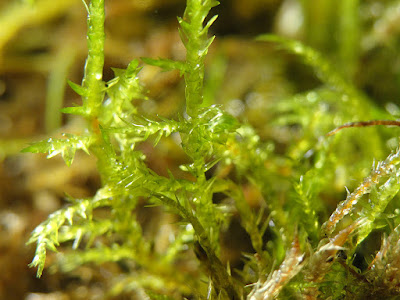... or, under every rock, a new marvel.
I flipped a broken paving stone at the top of the intertidal zone, just off the end of the boat ramp. Here, the shore is rocky and difficult underfoot; long ago, someone laid out a few square pavers, but with time and heavy traffic, they have all broken, and lie helter-skelter among the more "natural" rocks. At high tide, the water covers the end of the ramp, and is about a foot deep over this rocky stretch.
But the tide was going down; the stones were exposed but still wet. Flipping a few disturbed hermit crabs and a handful of green and purple shore crabs. A larger stone, lying not quite flat on the rocks, had a pool of water underneath, and in this pool was a fish.
 |
| Plainfin midshipman, Porichthys notatus, aka the singing toadfish. |
 |
| Detail of the round fins and strong spines on the back. |
This was the same species as the one we found out of the water last week at White Rock, and about the same size; approximately 10 inches long.
He -- it's a male -- wasn't alone. The underside of the rock was covered with a layer of eggs.
 |
| A brilliant orange, shining in the sunlight. |
 |
| Part of the mass of eggs was shimmering and vibrating constantly. I couldn't see what was happening, ... |
 |
| but the camera could. Look closely. See the eyes? And the translucent , pink, comma-shaped bodies? The're fry; baby fish. Cute! |
Singing toadfish come in three types; females, and two different males; they call them Type I males and Type II males.
Type I males are eight times larger in body mass, and have much larger vocal organs. Type II males’ reproductive organs are seven times the size of type I males. Female and type II male midshipman fish can be distinguished from each other by the female’s slightly larger size, and the type II male midshipman’s large reproductive organs. (Wikipedia)
The way it works is this; a large Type I finds himself a nice rock to hide under near the top of the intertidal zone, and digs a nest. When night comes, he starts to sing. (Well, sort of; it's a
hum or a buzz.
Listen. Whatever you call it, the female likes it.) When a female joins him, she lays her eggs on the underside of the sheltering rock and he fertilizes them. Then she leaves, and he babysits until the eggs hatch and the young fry leave the nest.
And where do Type II males come into it? They are about the size of a female, and their voice is similar to hers. Their mating strategy is to deceive a Type I into mistaking them for females and allowing them to enter his nest. Then the two wait together for a mate; when she arrives, sneaky Type II fertilizes the eggs, and swims away, leaving the cuckolded Type I to do the job of parenting.
These fish are nocturnal; even when they're not brooding, they hide under rocks during the day. At night, they hover over the bottom, laying in wait for prey. On their sides and belly, they have rows of cells which, if their diet includes the right species of copepods, emit light. This may serve as
camouflage against the lighter sky, or possibly may
attract prey.
 |
| The fish at White Rock, showing the lines of photopores. |
There's a great photo of
eggs and fry on Flickr.
Buzz has photos of a raccoon catching and eating these fish.
A
good photo of the photopores and a note about poisonous spines. Warning: hands off!



































